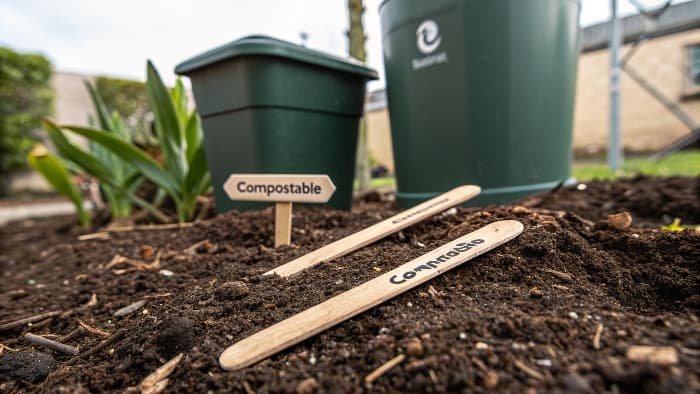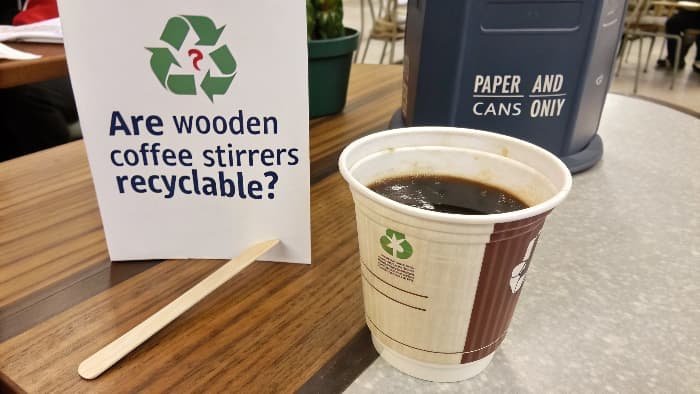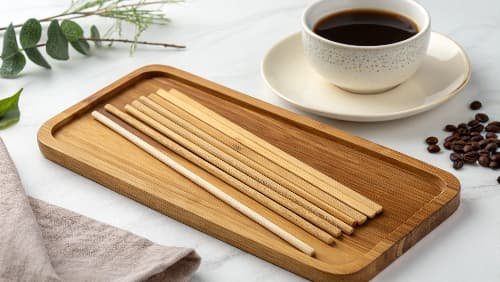Confused about eco-friendly stirrers? Wood or bamboo – which truly helps the planet and your cafe shine with green credentials? Making the wrong choice feels like a step backward.
Generally, bamboo coffee stirrers offer a more sustainable edge over traditional wood due to bamboo’s rapid growth, lower environmental impact during cultivation, and efficient carbon sequestration.
I get this question a lot from clients looking to green their operations here at Ecosourcecn. It’s a valid one! Both seem natural, right? But when you dig a little deeper, the differences start to show. It’s not just about avoiding plastic – a huge problem we’re all tired of – it’s about choosing the best natural alternative. Honestly, it can feel like a bit of a minefield. Let’s stir things up and find out which one truly comes out on top for sustainability!
Are wooden or plastic coffee stirrers better?
Stuck between plastic’s obvious harm and wondering about wood? Which path truly lessens your cafe’s environmental footprint and keeps customers happy?
Wooden stirrers are significantly better than plastic due to their biodegradability and renewable origin. Plastic pollutes for centuries, while wood can return to the earth, thankfully!
Okay, so the question mentions plastic. Let’s get that out of the way first – it’s a no-brainer that wooden stirrers (and bamboo, which we’ll get to in a moment, promise!) are miles ahead of plastic. I mean, we’ve all seen the heartbreaking images of plastic pollution in our oceans and waterways. At Ecosourcecn, phasing out single-use plastics is at the very heart of what we do. Plastic stirrers, often made from polystyrene or polypropylene, are derived from fossil fuels. Their production is energy-intensive, and they stick around in the environment for hundreds, if not thousands, of years, breaking down into those nasty microplastics. Yuck!
Now, shifting the focus to wood within the "better than plastic" context:
Wood’s Eco-Advantages (Compared to Plastic)
- Renewable Resource: Trees, especially when they’re managed sustainably (you should always look for that FSC – Forest Stewardship Council certification!), are a renewable resource. This is a massive plus compared to finite fossil fuels.
- Biodegradability: Wood is naturally biodegradable. If a wooden stirrer accidentally ends up in the environment (though we hope it goes to compost!), it will eventually decompose. Plastic, on the other hand, just hangs around.
- Lower Carbon Footprint (Often): The journey of a wooden stirrer, from forest to your coffee cup, generally has a lower carbon footprint than its plastic counterpart. This is especially true if the wood is sourced locally and from forests that are managed well.
However, "wood" is a pretty broad term, isn’t it? The type of wood really matters, and so does how it’s sourced. This is where the comparison with bamboo gets really interesting. While wood is a big step up from plastic, we’re always asking ourselves at Ecosourcecn: can we do even better? My colleague Jacky, our Canadian packaging specialist, is always pushing us to find the most sustainable option that still performs brilliantly and meets all the necessary compliance standards. This leads us directly to comparing different types of natural stirrers.Are wooden coffee stirrers compostable?
Want your cafe’s waste to nourish the earth, not just fill up landfills? Can those little wooden stirrers actually be composted properly?
Yes, untreated wooden coffee stirrers are generally compostable in both home and industrial composting systems, breaking down naturally into valuable organic matter.

This is a great question, and the answer is usually a resounding "yes!" – which is fantastic news for any eco-conscious business. I remember when we first started looking into sustainable alternatives for a large coffee chain client a few years back; compostability was right at the top of their must-have list. It makes such a difference to the end-of-life story of a product.
The Breakdown on Wooden Stirrer Composting
So, how does it work?
- Natural Material: Wood is, at its core, organic material. Given the right conditions – that’s a bit of moisture, some oxygen, and a healthy community of microorganisms – it will naturally decompose. Think about a fallen branch in a forest; it doesn’t stick around forever, it eventually returns to the soil. Wooden stirrers are no different.
- Home Composting: Those small, thin wooden stirrers can typically break down just fine in a well-managed home compost bin. It might take a little longer than, say, your vegetable scraps or grass clippings, but they’ll get there. I toss mine in my backyard compost all the time, and they disappear eventually!
- Industrial Composting: They’ll break down even faster in industrial composting facilities. These places are designed to optimize the composting process, with higher temperatures and carefully controlled conditions.
- What to Watch Out For – A Little Caveat:
- Coatings or Additives: Make absolutely sure the stirrers are plain, untreated wood. Some novelty stirrers out there (you know, the colorful or fancy ones?) might have paints, lacquers, or other chemical treatments. These could hinder the composting process or, worse, release undesirable substances into your lovely compost. At Ecosourcecn, we always verify that the wooden products we source are free from such contaminants – it’s a deal-breaker for us.
- Quantity Matters: If you’re a high-volume cafe, simply chucking thousands of stirrers into a small office compost bin might overwhelm it. Proper composting infrastructure, whether that’s a larger on-site system for very big operations or using a commercial composting service, is really key to handling larger volumes effectively.
For someone like Jacky, ensuring a product is truly compostable and doesn’t just claim to be is absolutely vital. He always digs into the details, looking for clarity on materials and any treatments. So, if you’re using standard, plain wooden stirrers, you can confidently tell your customers they are compostable. This contributes to a much more circular economy approach, turning "waste" into a valuable resource (hello, nutrient-rich compost!). It’s a much, much better story than "goes to landfill."Are wooden coffee stirrers recyclable?
Hoping to just toss those used wooden stirrers into the recycling bin alongside your paper and cans? Is that the right way to dispose of them sustainably?
Generally, no, used wooden coffee stirrers are not recyclable through typical municipal recycling programs. Their small size and potential food contamination make them unsuitable.

This is a common point of confusion, and I totally get why. People often think, "Well, wood is a natural material, and we recycle paper, so wooden stirrers should be recyclable too, right?" Unfortunately, it’s usually not the case, at least not with our standard recycling systems. I had this exact conversation with Jacky just last month when he was evaluating a new potential supplier who made some slightly confusing claims.
Why Recycling Isn’t the Best Path for Wooden Stirrers
Let’s break down why these little guys usually can’t go in the blue bin:
- Size Matters (And They’re Too Small!): Most recycling facilities, or Material Recovery Facilities (MRFs) as they’re known in the biz, use large machinery with screens and sorters designed to handle bigger items like bottles, jugs, cans, and bundles of paper. Tiny items like stirrers, bottle caps, or even plastic straws often fall through the sorting screens. When they do, they either end up contaminating other recyclables or just get sent to the landfill pile anyway. Sometimes, they can even jam the machinery – a real headache for recycling operators. It’s a bit like trying to catch a tiny fish with a giant net; it just doesn’t work well.
- Food Contamination – The Recycler’s Enemy: Wooden stirrers are, by their very nature, used with liquids and often have coffee, tea, or sugar residue stuck to them. Food contamination is a major spoiler in recycling streams. It can lower the quality of valuable recyclable materials like paper and cardboard, making them less valuable or, in some cases, completely unusable. Most recycling programs have strict rules that items should be clean and dry. A sticky, wet coffee stirrer just doesn’t fit the bill.
- Material Type Mismatch: While wood itself is a valuable material, our current municipal recycling programs are typically geared towards specific, high-volume material streams like paper, cardboard, certain types of plastics (like PET #1 and HDPE #2), glass, and metals. They usually don’t have a separate, established stream for collecting and processing small wooden items.
So, what’s the main takeaway here? Please don’t throw your wooden stirrers in the recycling bin. The much better, and actually intended, end-of-life pathway for them is composting. This way, they return to the earth as nutrients, completing a natural cycle. At Ecosourcecn, we always emphasize the correct disposal method for each and every product we offer. It’s all about guiding our clients, like Jacky’s eco-conscious company in Canada, to not just buy sustainable products but also to fully understand and effectively communicate how to dispose of them in the most sustainable way possible. That education piece is huge!Are bamboo coffee stirrers safe?
Thinking about switching to bamboo stirrers for your eco-conscious cafe? But wait – are they actually safe for your customers to use with their hot drinks?
Yes, bamboo coffee stirrers are generally very safe for food contact. Bamboo is naturally antimicrobial and typically requires no pesticides or fertilizers for its rapid growth.

Safety is absolutely paramount, especially when it comes to anything that touches our food or drink. It’s a question Jacky, with his keen eye for detail and background in Environmental Science, always asks, and it’s one we take incredibly seriously here at Ecosourcecn. The fantastic news is that bamboo has some amazing natural properties that make it an excellent and safe choice for food-contact items like stirrers. I was so impressed when I first learned about this!
Bamboo’s Impressive Safety Profile:
Let’s look at why bamboo is a winner for safety:
- Naturally Antimicrobial Properties: This is pretty cool – bamboo contains a natural antimicrobial bio-agent called "bamboo kun." This substance helps the bamboo plant resist pests and fungal attacks while it’s growing. These beneficial properties can carry over to the final product, making bamboo items naturally more hygienic. This often means there’s less need for any chemical treatments during processing, which is always a plus.
- No Nasty Pesticides or Fertilizers (Usually!): Bamboo is a real trooper in the plant world. It’s a hardy and incredibly fast-growing grass (not a tree, which surprises many people!). It generally doesn’t require any pesticides, herbicides, or fertilizers to thrive. This is a big contrast to some conventionally grown timber crops, which can be quite input-heavy. The lack of these chemicals reduces the risk of any harmful residues ending up in the final stirrer product.
- Meeting Food-Grade Standards: Reputable manufacturers, like the ones we partner with at Ecosourcecn, produce bamboo stirrers to meet stringent food-grade safety standards. These often include certifications like FDA (U.S. Food and Drug Administration) approval or LFGB (German Food and Commodities Act) compliance. These tests ensure that no harmful substances leach from the stirrers into food or beverages, even hot ones. For us, these certifications are completely non-negotiable; they’re a baseline for trust.
- A Smooth, Splinter-Free Finish: Good quality bamboo stirrers are manufactured to have a very smooth finish. This significantly reduces the risk of splinters, which can sometimes be a concern with lower-quality or poorly finished wooden stirrers. No one wants a splinter in their latte!
- Simplicity in Material (No Added Glues or Lacquers for Stirrers): For simple, single-piece items like coffee stirrers, they are typically just shaped bamboo – nothing added. While more complex bamboo products (like some types of cutting boards or utensils) might use food-safe adhesives, for basic stirrers, it’s usually not a factor at all.
So, yes, you can feel confident that bamboo stirrers are a safe bet. I always tell my clients, including those as meticulous and demanding as Jacky, that choosing bamboo is not just an environmental win; it’s also a safe, high-quality, and reliable choice for their customers. It’s a durable, clean, and beautifully natural material – absolutely perfect for stirring that morning coffee or afternoon tea! Plus, they just look and feel nice, don’t they?Conclusion
Bamboo stirrers generally offer superior sustainability over wood due to fast growth and CO2 absorption, making them an excellent choice for eco-conscious businesses. They’re safe, compostable, and customer-approved!


